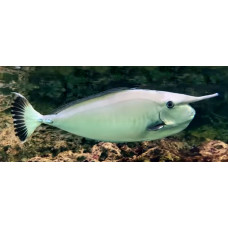Latin name
Naso annulatus
Other name
Ringtailed unicornfish, short-horned unicorn-fish.
Identification
The body has a standard length that is 2.2 to 3 times its thickness, deepest in adults. In front of the eyes there is a long, horizontal, upwardly tapering bony prominence that first appears as a tubercle in individuals less than 20 cm (7.9 in) in total length. The angle between the snout and the tubercle is approximately 60°. The caudal peduncle has 2 bony plates on each side, and adults develop lobed keels on them. In juveniles the caudal fin is pointed, but in adults it becomes toothed, and in males long filaments appear at the tips of the blades.
Features of fish fins
The dorsal fin is supported by 5 spines and 28 or 29 soft rays, while the anal fin contains 2 spines and 27 or 28 soft rays.
Fish colouring
Background coloration is bluish gray or bluish brown, paler on the lower body, without dark markings. They have white lips, and juveniles and not very mature individuals have a distinct white stripe on the caudal peduncle and a white edge to the caudal fin. As they mature, they develop a black underwater stripe on the caudal fin and retain a thin white border and tail filaments.
Distribution
Widespread in the Indo-Pacific region, occurring from the Red Sea and the east coast of Africa eastward to Cocos Island, part of Costa Rica.
Habitat
A marine tropical species. Juveniles are found in shallow, clear water on reefs in lagoons to 1 m (3 ft 3 in) deep, and adults are rarely found at depths less than 25 m (82 ft) near the outer walls of reefs.
Size
With a maximum total length of 100 cm (39 inches), it is the largest species in the genus Naso and one of the largest species in the Acanthuridae.
Behavior
Swim in small schools near the outer edges of the reef.
Food and feeding habits
Juveniles feed on filamentous green algae, while adults, whose total length exceeds 20 centimeters (7.9 inches), change their diet to soft zooplankton such as comb and jellyfish.
Reproduction
Males and females form pairs to spawn.
Fishing
Have negligible commercial value in the fishery.
Relationship with a person
There have been reports of ciguatera poisoning. They are used in aquariums.
| Classification | |
| Phylum | Chordata |
| Class | Actinopterygii |
| Squad | Acanthuriformes |
| Family | Acanthuridae |
| Genus | Naso |
| Species | N. annulatus |
| Features | |
| Conservation status | Least Concern |
| Habitat | Pelagic |
| Life span, years | No information |
| Maximum body weight, kg | No information |
| Maximum length, cm | 100 |
| Sailing speed, m/s | No information |
| Threat to people | Edible |
| Way of eating | Bentophage |
Whitemargin unicornfish
Tags: whitemargin unicornfish


